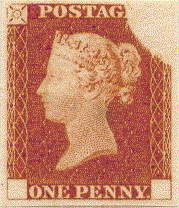
Rainbow Trial in red-brown Second Trial State 3

Rainbow Trial in red-brown Second Trial State 3
The "Rainbow" Color Trials were produced to experiment with various different combinations of stamp and
cancellation inks. The First Trial was a small plate of three impressions without corner letters and with the top
right corner of each impression voided. The impressions of this trial show the "O" Flaw later seen on the issued
stamps from Plates 7, 8, 9 and 10. Proofs are known:a) On paper watermarked Small Crown in mauve-pink, lilac-brown, blue-black.
b) On similar paper dipped in prussiate of potash in blue-black.
c) On white wove paper in deep blue.
d) On white wove paper dipped in prussiate of potash in deep blue.
The Second Trial Plate produced twelve impressions instead of three in the case of the first trial. The second trial
exists in three states. The trial produced impressions without the "O" Flaw and Flaw and thecorner letters were
also voided. The upper right corner of each plate was by filling in the plate grooves with wax. The three states
are described as follows:State 1: Proof sheets in this state are known in black, orange-red, reddish-brown and deep blue.
State 2: Same as State 1 but with a tiny dash at the bottom line of the south-east corner square
of the second stamp of the third row. Proof sheets are known as follows:a) On white wove paper dipped in prussiate of potash in lilac-pink, lilac- rose, dull rose-red, deep blue.
b) On stout rough white wove paper in black, rose-red, deep blue.
c) On thin white wove paper in bright pink, lilac-rose, dull rose-red, deep rose-red, lilac-brown, deep
red-brown, black, red, blue, deep dull lue, prussian-blue, dull lilac.d) On thick bluish laid paper (June 1840) in dull red, brownish rose-red, deep rose-red.
e) A proof in black on paper stained with prussiate of potash, logwood and cochineal, giving a lilac-
rose tinge to the paper (August 1840).In State 3 the voided corners are more uniform in shape compared with the ragged corners of the States 1 and 2. Proof
sheets are known as follows:a) On white wove paper dipped in prusiate of potash in red, red-brown, rose-red, deep blue, black.
b) On white wove paper in red, pale red, red-brown, crimson red, dull blue, deep blue, prussian blue,
yellow-green, deep green. (See illustred example above).c) On Small Crown watermarked paper, usually sideways (September 1840), in red-brown, blue
d) On thick bluish laid paper (November 20 1840), in blue, dull blue, green, bluish-green, dark olive-
green, drab.e) On thick bluish laid paper dipped in prussiate of pot ash (November 1840), in dark olive-green.